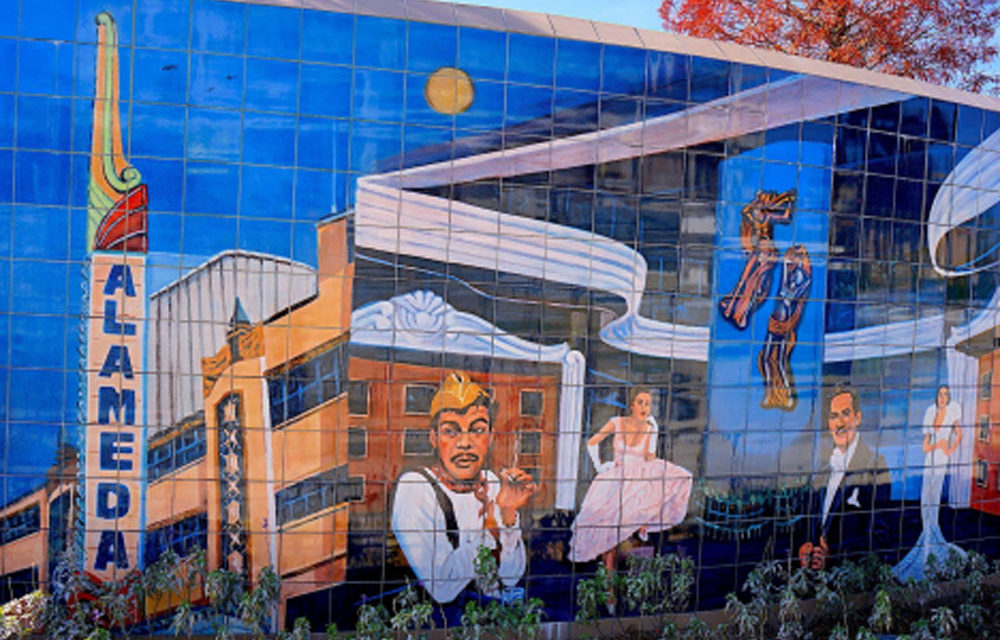By Dr. Ricardo Romo
When Joe Lopez was growing up, the most popular Spanish language movie theaters located on the western edge of downtown, just west of the San Pedro Creek, featured the latest Mexican films and stars. These cultural architectural landmarks included the Zaragoza, El Nacional, and the Alameda theaters. The Alameda, with its colorful Mexican tile on its floors and walls, emerged as the favorite among moviegoers who were fans of Pedro Infante, Maria Felix, Jorge Negrete, Dolores Del Rio, Cantinflas, and Tin Tan.
By the 1960s, as a result of urban renewal and commercial revitalization projects, only the Alameda theater remained. With these assertive urban “removal” efforts “Laredito,” [Little Laredo] as it was
known to local residents, ceased to exist. In a recent mural titled “Alameda,” Joe Lopez brought the highlight years of the Alameda to life again. Commissioned by the San Pedro Creek Culture Park, the tiled mural is one of several that brings historical memory to the old Mexican American community.
Joe Lopez grew up in one of the smallest and most isolated Mexican barrios in San Antonio. The barrio, “Barrio Escondido,” was next to the famous neighborhood, Cementville, where Mexican workers employed by the giant cement factory lived with their families. That neighborhood disappeared in the 1970s when the plant closed and developers turned the plant into the Quarry Shopping Center.
Lopez remembers Barrio Escondido as being all of two blocks. In the 1940s and 1950s when he was growing up there, his community had a rural feel to it. He grew up around small farm animals, and some families in the neighborhood raised chickens and roosters. Lopez was especially fond of roosters, or Gallos as they are called in Spanish.
Lopez’s teacher in the 8th grade, a Catholic nun, convinced the art teacher at the Witte Museum to take Lopez as a student noting that he would be willing to clean the studios after other students left. After high school, Lopez took art classes at La Villita School of Art and San Antonio School of Art. In the mid 1990s, he continued painting and earned extra money selling tee shirts and caps embossed with his favorite phrase, “Puro Gallo,” which means pure rooster in English. As a young boy Lopez had admired his neighbor’s roosters’ spunk.
In his modest sales and use of the word Gallo, however, Lopez apparently crossed the world’s largest winery, E&J Gallo Winery. The corporate attorneys somehow learned of Lopez’ “Puro Gallo” products and threatened to sue Lopez for trademark violations. The winery also demanded that Lopez cease using the word “Gallo” in any shape or form. Lopez and the art community were shocked. How could someone copyright a Spanish word, whether it is tierra, taco, cerveza or gallo?
After Filemon Vela,Jr., Lopez’ attorney, met with representatives of the Gallo company and they settled out of court. The Gallo Family had taken on David and, in this instance, Goliath gave up on its insane demands and went away. Lopez continued to produce “Puro Gallo” hats and soon decided to open a Latino gallery and studios in Southtown. With the help of his wife Frances, Gallista Gallery was born. Vela, who did not charge Lopez for legal representation, is now a congressman representing South Texas. Over the next decade, Lopez continued to paint while the Gallo Family fortune grew to an estimated $10.5 billion.
Lopez operated Gallista Gallery and art studios for nearly twenty years. The entrance to the Gallery had paintings and folk art crafts by local artists. Lopez maintained his own painting studio there and rented exhibition and studio space to many Latino artists. Over nearly two decades, Gallista Gallery hosted monthly art exhibitions, including altars during the Day of the Dead celebration.
Although Lopez’s style and techniques have evolved, he continues to paint mostly about his Mexican American culture and heritage. Joe Lopez and Gallista Gallery notes and sketches are archived by the prestigious Smithsonian Archives of American Art in Washington, DC, which is collecting his memorabilia.
Joe Lopez has returned to his family homestead, but he added a studio and gallery to the front of the house. Today he continues to paint beautiful cultural works and sell postcards and tee shirts. As for future plans, he only revealed: “It is great to be in the barrio where I grew up, and I’m happy to be painting full time.”
Joe Lopez Keeps Latino Cultural Heritage Visible









